2010 MERCEDES-BENZ CLS COUPE height
[x] Cancel search: heightPage 171 of 337
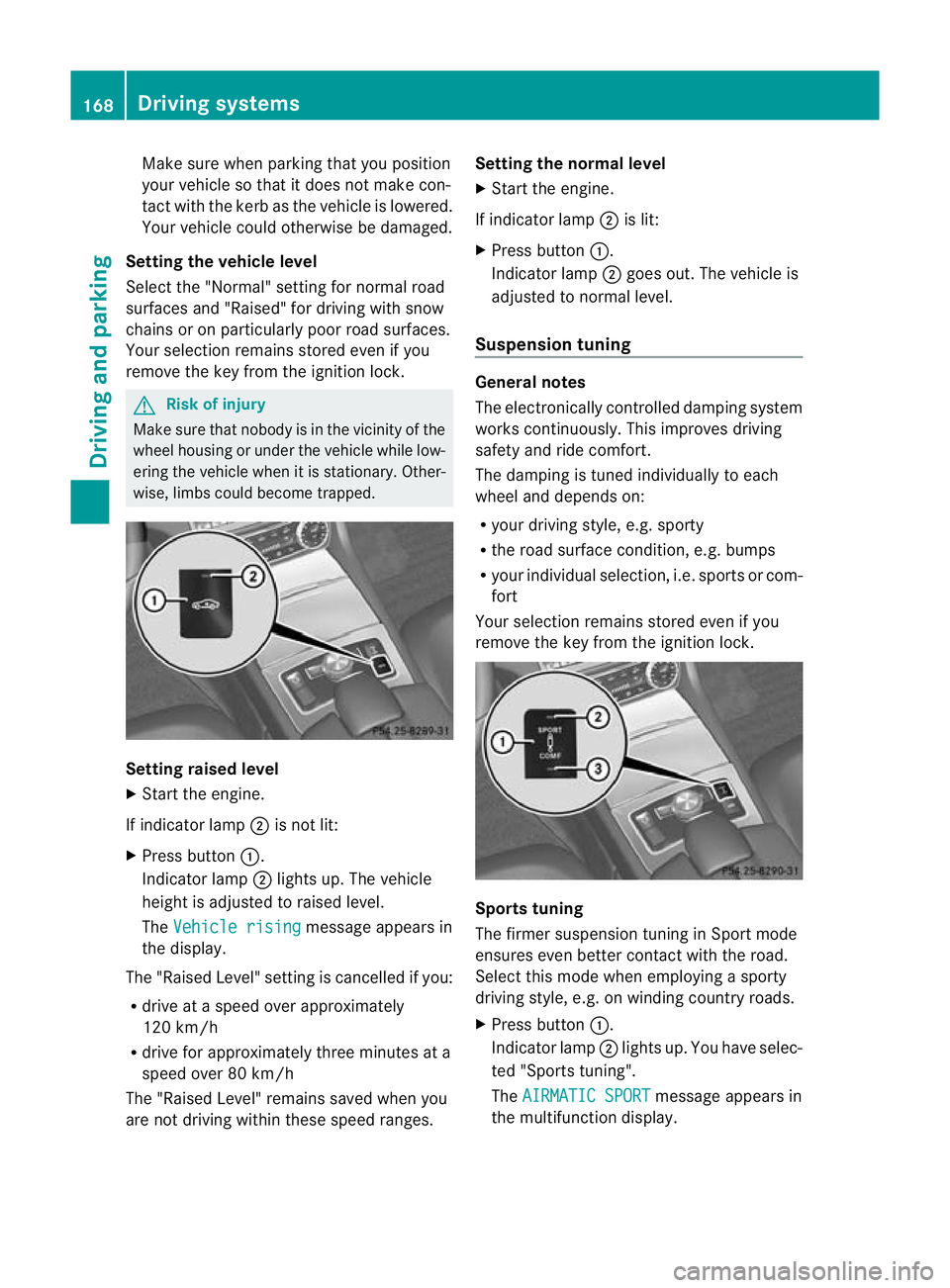
Make sure when parking that you position
your vehicle so that it does not make con-
tact with the kerb as the vehicle is lowered.
Your vehicle could otherwise be damaged.
Setting the vehicle level
Select the "Normal" setting for normal road
surfaces and "Raised" for driving with snow
chains or on particularly poor road surfaces.
Your selection remains stored even if you
remove the key from the ignition lock. G
Risk of injury
Make sure that nobody is in the vicinity of the
wheel housing or under the vehicle while low-
ering the vehicle when it is stationary. Other-
wise, limbs could become trapped. Setting raised level
X
Start the engine.
If indicator lamp ;is not lit:
X Press button :.
Indicator lamp ;lights up. The vehicle
height is adjusted to raised level.
The Vehicle rising message appears in
the display.
The "Raised Level" setting is cancelled if you:
R drive at a speed over approximately
120 km/h
R drive for approximately three minutes at a
speed over 80 km/h
The "Raised Level" remains saved when you
are not driving within these speed ranges. Setting the normal level
X
Start the engine.
If indicator lamp ;is lit:
X Press button :.
Indicator lamp ;goes out. The vehicle is
adjusted to normal level.
Suspension tuning General notes
The electronically controlled damping system
works continuously.T
his improves driving
safety and ride comfort.
The damping is tuned individually to each
wheel and depends on:
R your driving style, e.g. sporty
R the road surface condition,e .g. bumps
R your individual selection, i.e .sports or com-
fort
Your selection remains stored even if you
remove the key from the ignition lock. Sports tuning
The firmer suspension tunin
ginSport mode
ensures even better contact with the road.
Select this mode when employing a sporty
driving style, e.g. on winding country roads.
X Press button :.
Indicator lamp ;lights up. You have selec-
ted "Sports tuning".
The AIRMATIC SPORT message appears in
the multifunction display. 168
Driving systemsDriving and parking
Page 176 of 337
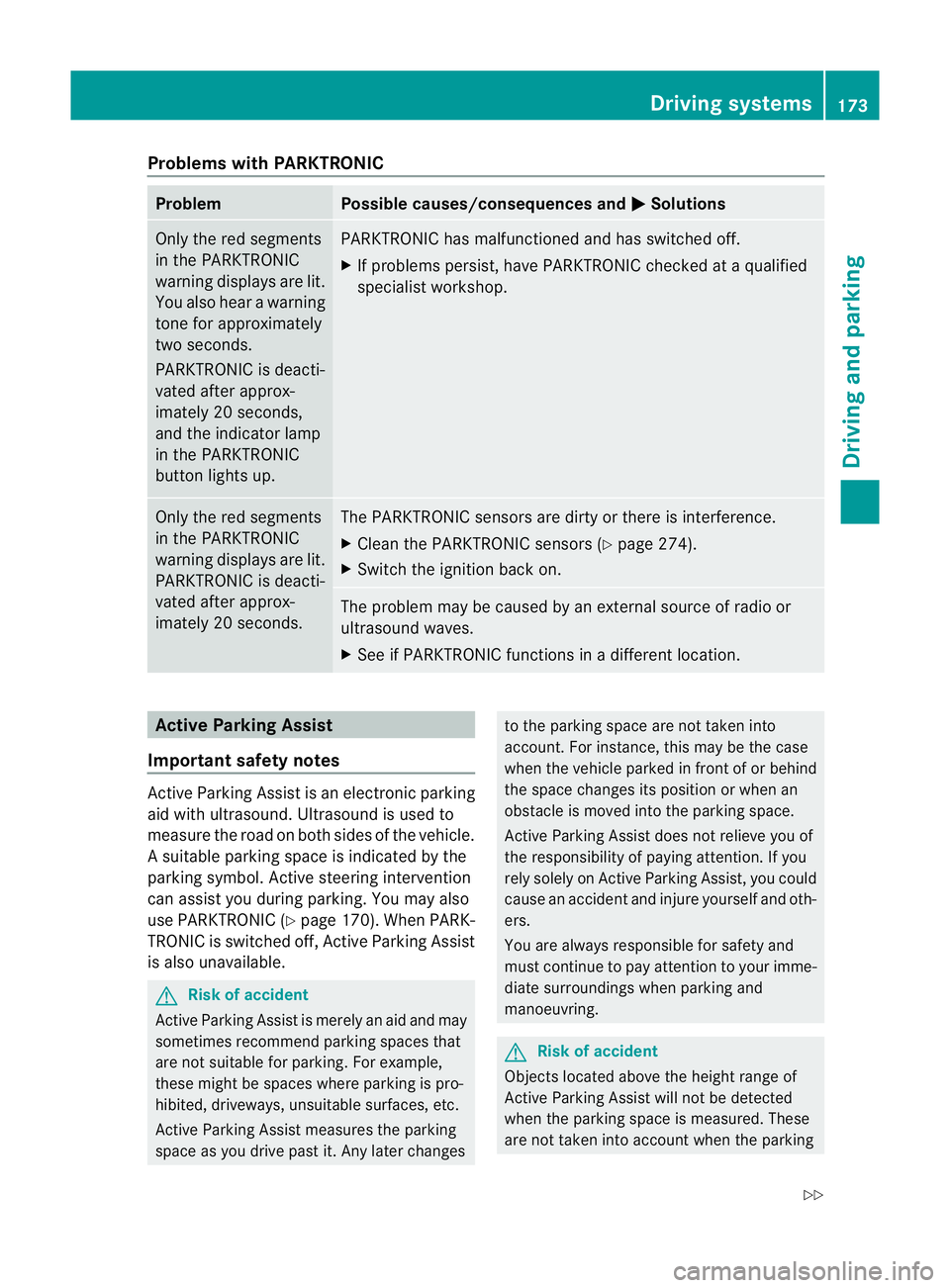
Problems with PARKTRONIC
Problem Possible causes/consequences and
M Solutions
Only the red segments
in the PARKTRONIC
warning displays are lit.
You also hear a warning
tone for approximately
two seconds.
PARKTRONIC is deacti-
vated after approx-
imately 20 seconds,
and the indicator lamp
in the PARKTRONIC
button lights up. PARKTRONIC has malfunctioned and has switched off.
X
If problems persist, have PARKTRONIC checked at a qualified
specialist workshop. Only the red segments
in the PARKTRONIC
warning displays are lit.
PARKTRONIC is deacti-
vated after approx-
imately 20 seconds. The PARKTRONIC sensors are dirty or there is interference.
X
Cleant he PARKTRONIC sensors (Y page 274).
X Switch the ignition back on. The problem may be caused by an external source of radio or
ultrasound waves.
X See if PARKTRONIC functions in a different location. Active Parking Assist
Important safety notes Active Parking Assist is an electronic parking
aid with ultrasound. Ultrasound is used to
measure the road on both sides of the vehicle.
As uitable parking space is indicated by the
parking symbol. Active steering intervention
can assis tyou during parking. You may also
use PARKTRONIC (Y page 170). When PARK-
TRONIC is switched off, Active Parking Assist
is also unavailable. G
Risk of accident
Active Parking Assist is merely an aid and may
sometimes recommend parking spaces that
are not suitable for parking. For example,
these might be spaces where parking is pro-
hibited, driveways, unsuitable surfaces, etc.
Active Parking Assist measures the parking
space as you drive past it. Any later changes to the parking space are not taken into
account. For instance, this may be the case
when the vehicle parked in front of or behind
the space changes its position or when an
obstacle is moved into the parking space.
Active Parking Assist does not relieve you of
the responsibility of paying attention. If you
rely solely on Active Parking Assist, you could
cause an accident and injure yourself and oth-
ers.
You are always responsible for safety and
must continue to pay attention to your imme-
diate surroundings when parking and
manoeuvring.
G
Risk of accident
Objects located above the height range of
Active Parking Assist will not be detected
when the parking space is measured. These
are not taken into account when the parking Driving systems
173Driving and parking
Z
Page 256 of 337
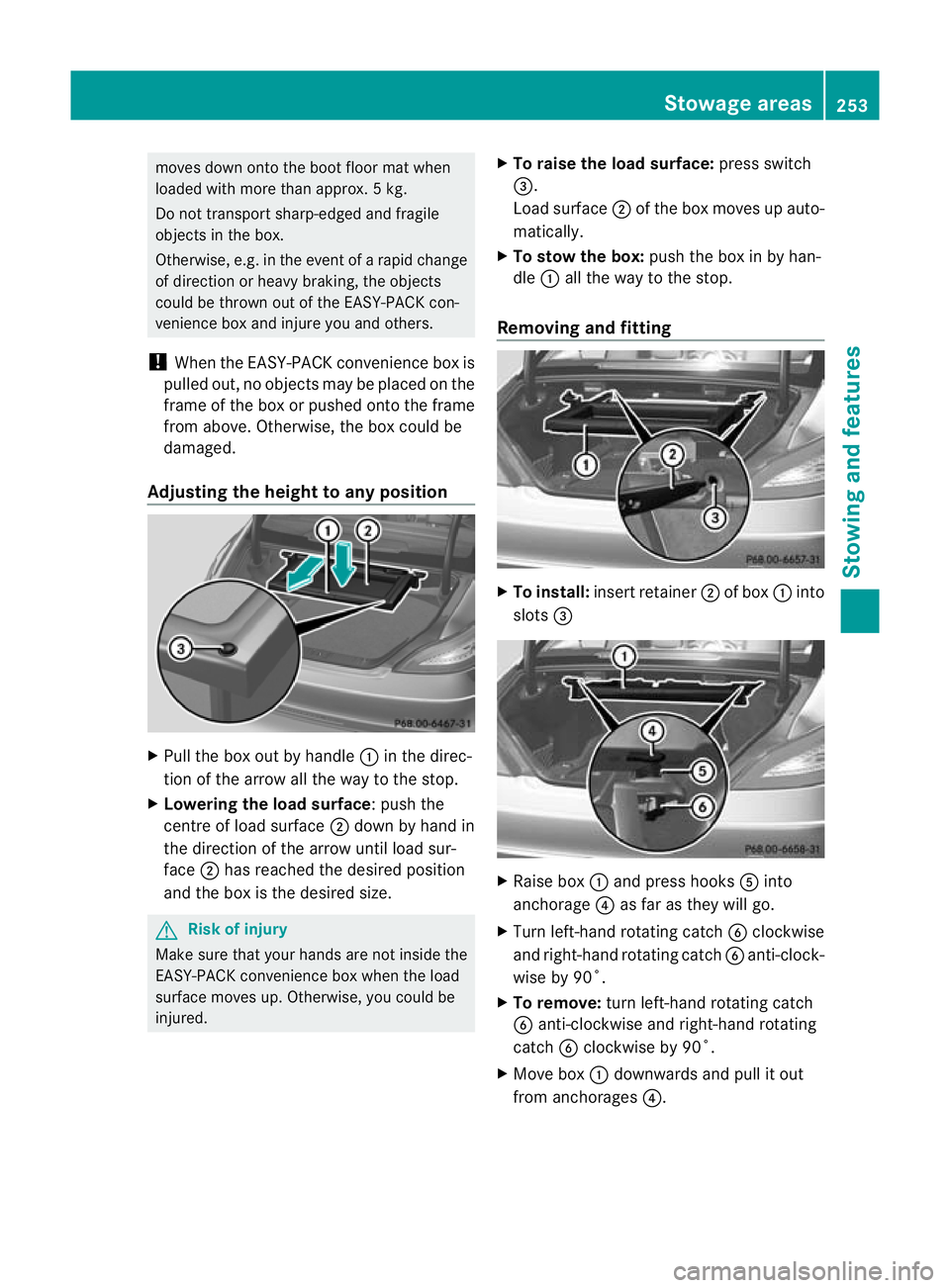
moves down onto the boot floor mat when
loaded with more than approx. 5kg.
Do not transpor tsharp-edged and fragile
objects in the box.
Otherwise, e.g. in the event of a rapid change
of direction or heavy braking, the objects
could be thrown out of the EASY-PACK con-
venience box and injure you and others.
! When the EASY-PACK convenience box is
pulled out, no objects may be placed on the
frame of the box or pushed onto the frame
from above. Otherwise, the box could be
damaged.
Adjusting the height to any position X
Pull the box out by handle :in the direc-
tion of the arrow all the way to the stop.
X Lowering the load surface:p ush the
centre of load surface ;down by hand in
the direction of the arrow until load sur-
face ;has reached the desired position
and the box is the desired size. G
Risk of injury
Make sure that your hands are no tinside the
EASY-PACK convenience box when the load
surface moves up .Otherwise, you could be
injured. X
To raise the load surface: press switch
=.
Load surface ;of the bo xmoves up auto-
matically.
X To stow the box: push the box in by han-
dle :all the way to the stop.
Removing and fitting X
To install: insert retainer ;of box :into
slots = X
Raise box :and press hooks Ainto
anchorage ?as far as they will go.
X Turn left-hand rotating catch Bclockwise
and right-hand rotating catch Banti-clock-
wise by 90˚.
X To remove: turn left-hand rotating catch
B anti-clockwise and right-hand rotating
catch Bclockwise by 90˚.
X Move box :downwards and pull it out
from anchorages ?. Stowage areas
253Stowing and features Z
Page 270 of 337
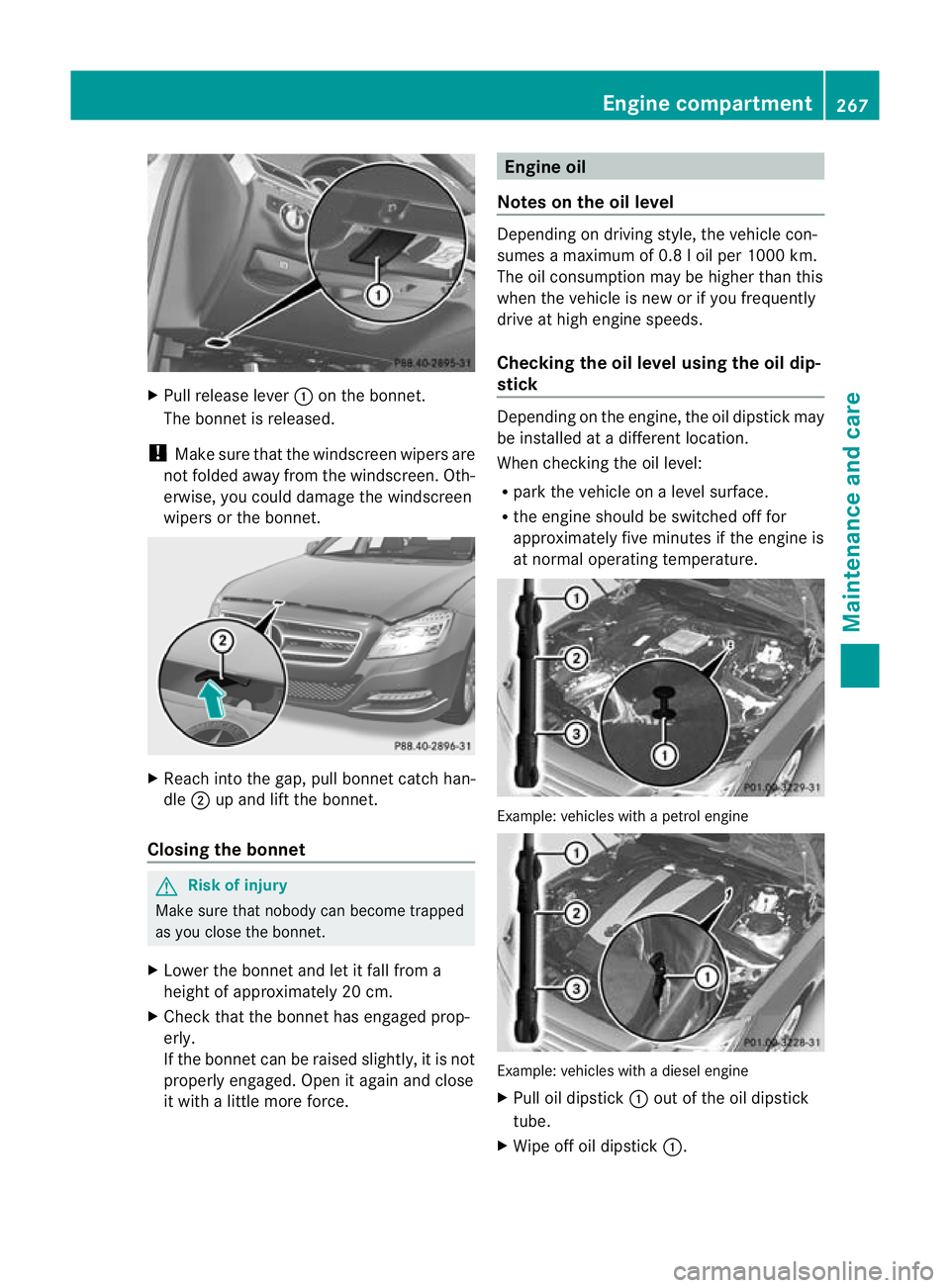
X
Pull release lever :on the bonnet.
The bonnet is released.
! Make sure that the windscreen wipers are
not folded away from the windscreen .Oth-
erwise, you could damage the windscreen
wipers or the bonnet. X
Reach into the gap, pull bonnet catch han-
dle ;up and lift the bonnet.
Closing the bonnet G
Risk of injury
Make sure tha tnobody can become trapped
as you close the bonnet.
X Lower the bonnet and let it fall from a
height of approximately 20 cm.
X Check that the bonnet has engaged prop-
erly.
If the bonnet can be raised slightly, it is not
properly engaged. Open it again and close
it with a little more force. Engine oil
Notes on the oil level Depending on driving style, the vehicle con-
sumes a maximum of 0.8 l oil per 1000 km.
The oil consumption may be higher than this
when the vehicle is new or if you frequently
drive at high engine speeds.
Checking the oil level using the oil dip-
stick
Depending on the engine, the oil dipstick may
be installed at a different location.
When checking the oil level:
R
park the vehicle on a level surface.
R the engine should be switched off for
approximately five minutes if the engine is
at normal operating temperature. Example: vehicles with a petrol engine
Example: vehicles with a diesel engine
X
Pull oil dipstick :out of the oil dipstick
tube.
X Wipe off oil dipstick :. Engine compartment
267Maintenance and care Z
Page 326 of 337
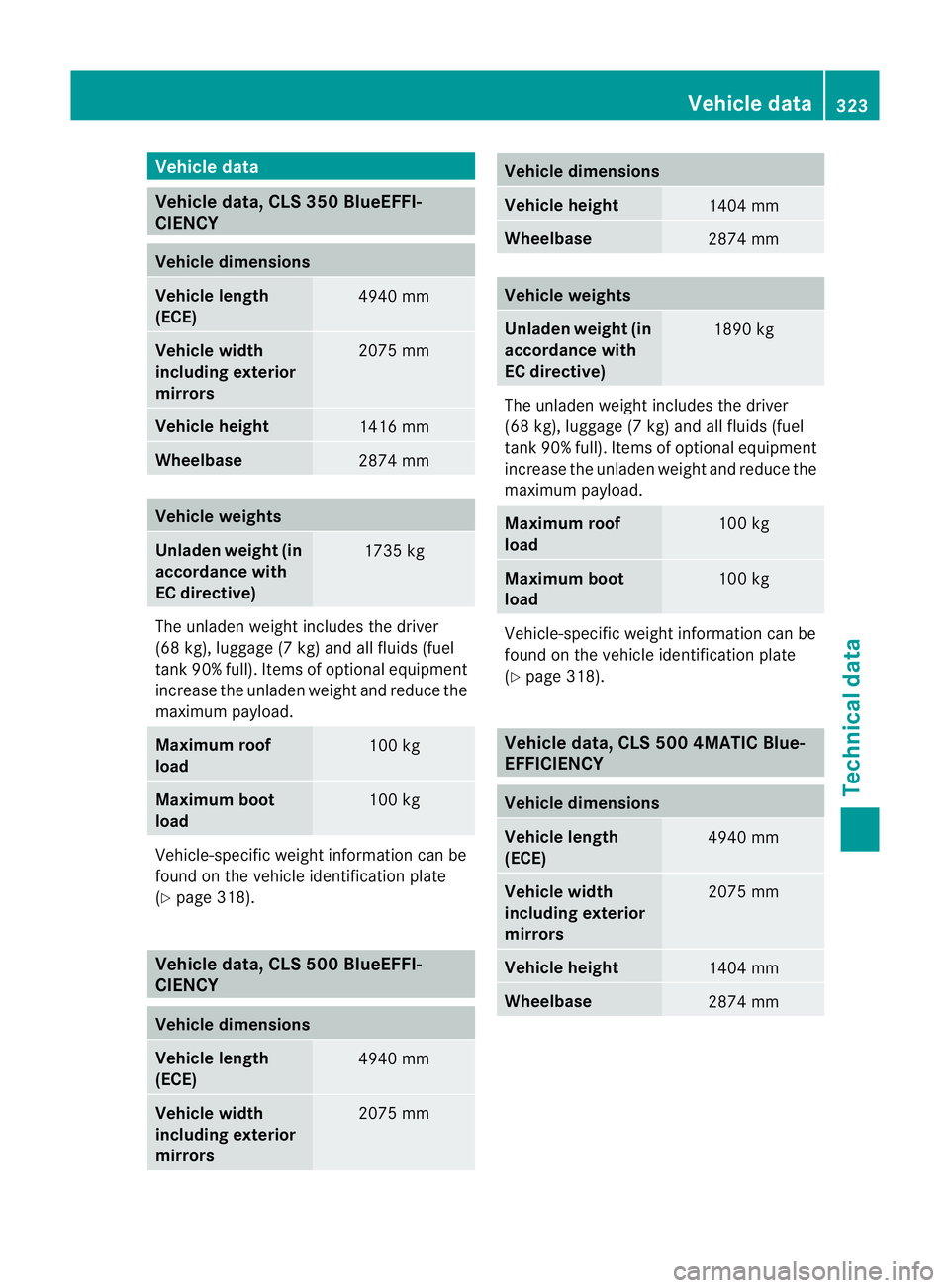
Vehicle data
Vehicle data, CLS 35
0BlueEFFI-
CIENCY Vehicle dimensions
Vehicle length
(ECE)
4940 mm
Vehicle width
including exterior
mirrors
2075 mm
Vehicle height
1416 mm
Wheelbase
2874 mm
Vehicle weights
Unladen weight (in
accordance with
EC directive)
1735 kg
The unladen weight includes the driver
(68 kg), luggage (7 kg) and all fluids (fuel
tan k90% full). Items of optional equipment
increase the unladen weight and reduce the
maximu mpayload. Maximum roof
load
100 kg
Maximum boot
load
100 kg
Vehicle-specific weigh
tinformation can be
found on the vehicle identificatio nplate
(Y page 318). Vehicle data
,CLS 500 BlueEFFI-
CIENCY Vehicle dimensions
Vehicle length
(ECE)
4940 mm
Vehicle width
including exterior
mirrors
2075 mm Vehicle dimensions
Vehicle height
1404 mm
Wheelbase
2874 mm
Vehicle weights
Unladen weight (in
accordance with
EC directive)
1890 kg
The unlade
nweight includes the driver
(68 kg), luggage (7 kg) and all fluids (fuel
tank 90% full). Items of optional equipment
increase the unladen weight and reduce the
maximum payload. Maximum roof
load
100 kg
Maximum boot
load
100 kg
Vehicle-specific weight information can be
found on the vehicle identification plate
(Y
page 318). Vehicle data, CLS 500 4MATIC Blue-
EFFICIENCY
Vehicle dimensions
Vehicle length
(ECE)
4940 mm
Vehicle width
including exterior
mirrors
2075 mm
Vehicle height
1404 mm
Wheelbase
2874 mmVehicle data
323Technical data Z
Page 327 of 337
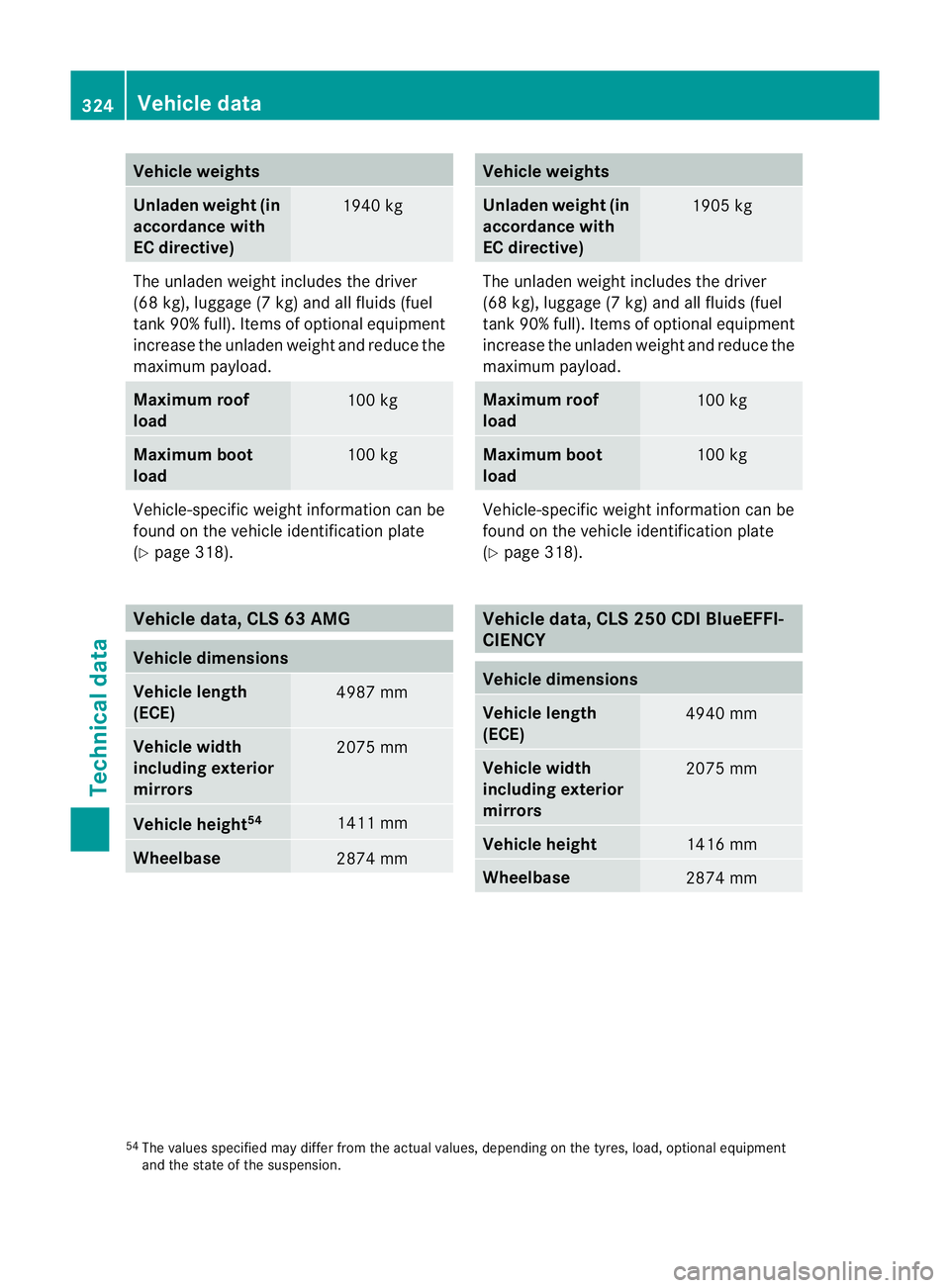
Vehicle weights
Unladen weight (in
accordance with
EC directive)
1940 kg
The unladen weight includes the driver
(68 kg), luggage (7 kg) and all fluids (fuel
tank 90% full) .Items of optional equipment
increase the unladen weight and reduce the
maximum payload. Maximum roof
load
100 kg
Maximum boot
load
100 kg
Vehicle-specifi
cweight information can be
found on the vehicle identification plate
(Y page 318). Vehicle data, CLS 63 AMG
Vehicle dimensions
Vehicle length
(ECE)
4987 mm
Vehicle width
including exterior
mirrors
2075 mm
Vehicle height
54 1411 mm
Wheelbase
2874 mm Vehicle weights
Unladen weight (in
accordance with
EC directive)
1905 kg
The unladen weight includes the driver
(68 kg), luggage (7 kg) and all fluids (fuel
tank 90% full). Items of optional equipment
increase the unladen weight and reduce the
maximum payload. Maximum roof
load
100 kg
Maximum boot
load
100 kg
Vehicle-specific weight information can be
found on the vehicle identification plate
(Y
page 318). Vehicle data, CLS 250 CDI BlueEFFI-
CIENCY
Vehicle dimensions
Vehicle length
(ECE)
4940 mm
Vehicle width
including exterior
mirrors
2075 mm
Vehicle height
1416 mm
Wheelbase
2874 mm
54
The values specified may differ from the actual values, depending on the tyres, load, optional equipment
and the state of the suspension. 324
Vehicle dataTechnical data
Page 328 of 337
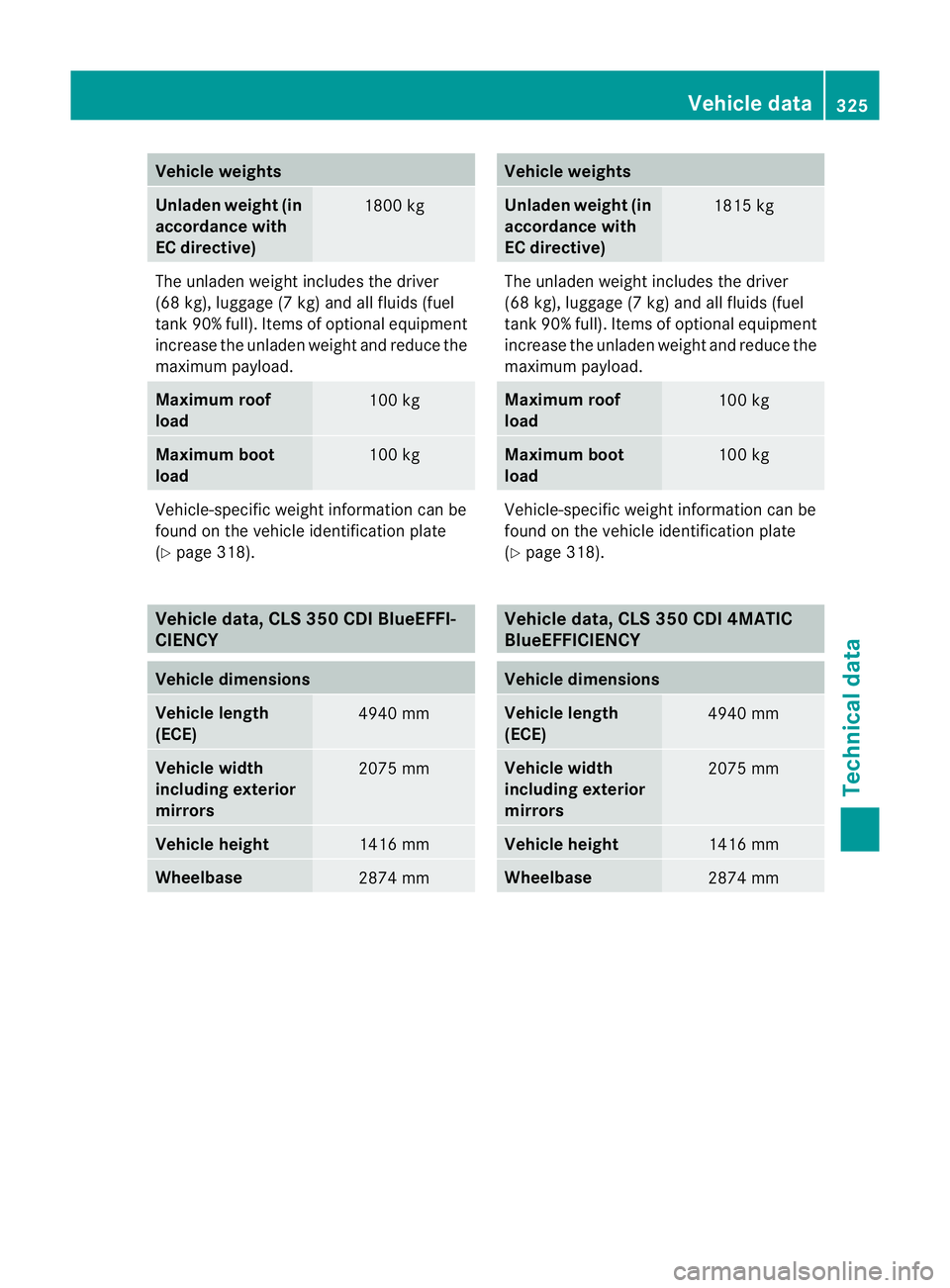
Vehicle weights
Unladen weight (in
accordance with
EC directive)
1800 kg
The unladen weight includes the driver
(68 kg), luggage (7 kg) and all fluids (fuel
tank 90% full) .Items of optional equipment
increase the unladen weight and reduce the
maximum payload. Maximum roof
load
100 kg
Maximum boot
load
100 kg
Vehicle-specifi
cweight information can be
found on the vehicle identification plate
(Y page 318). Vehicle data, CLS 350 CDI BlueEFFI-
CIENCY
Vehicle dimensions
Vehicle length
(ECE)
4940 mm
Vehicle width
including exterior
mirrors
2075 mm
Vehicle height
1416 mm
Wheelbase
2874 mm Vehicle weights
Unladen weight (in
accordance with
EC directive)
1815 kg
The unladen weight includes the driver
(68 kg), luggage (7 kg) and all fluids (fuel
tank 90% full). Items of optional equipment
increase the unladen weight and reduce the
maximum payload.
Maximum roof
load
100 kg
Maximum boot
load
100 kg
Vehicle-specific weight information can be
found on the vehicle identification plate
(Y
page 318). Vehicle data, CLS 350 CDI 4MATIC
BlueEFFICIENCY
Vehicle dimensions
Vehicle length
(ECE)
4940 mm
Vehicle width
including exterior
mirrors
2075 mm
Vehicle height
1416 mm
Wheelbase
2874 mmVehicle data
325Technical data Z
Page 329 of 337
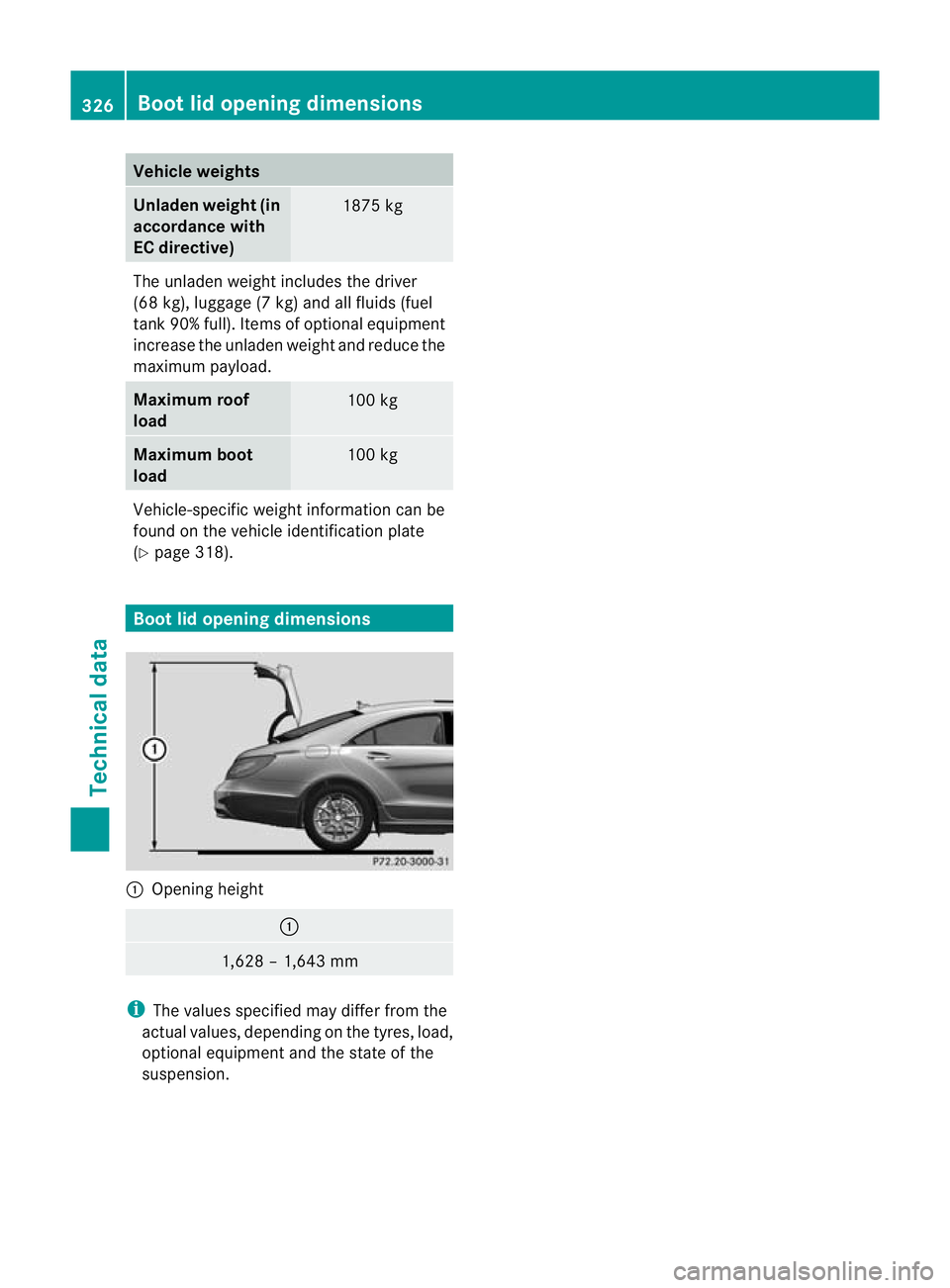
Vehicle weights
Unladen weight (in
accordance with
EC directive)
1875 kg
The unladen weight includes the driver
(68 kg), luggage (7 kg) and all fluids (fuel
tank 90% full) .Items of optional equipment
increase the unladen weight and reduce the
maximum payload. Maximum roof
load
100 kg
Maximum boot
load
100 kg
Vehicle-specifi
cweight information can be
found on the vehicle identification plate
(Y page 318). Boot lid opening dimensions
:
Opening height :
1,628 – 1,643 mm
i
The values specified may differ from the
actual values, depending on the tyres, load,
optional equipment and the state of the
suspension. 326
Boot lid opening dimensionsTechnical data